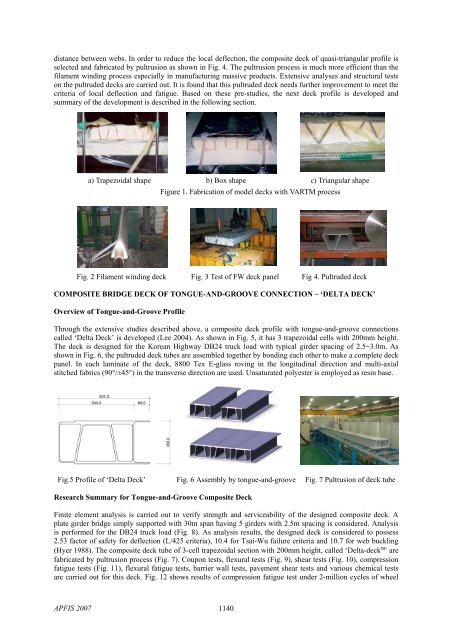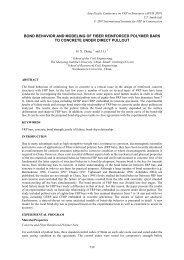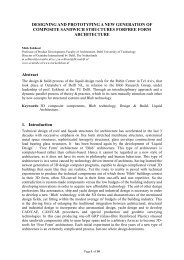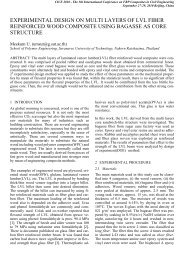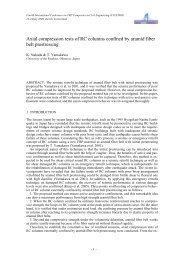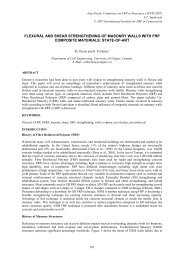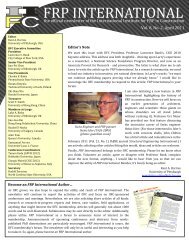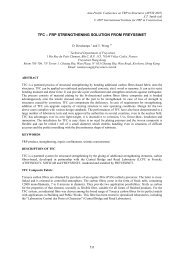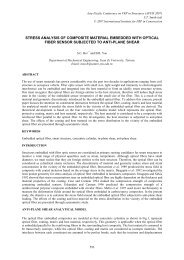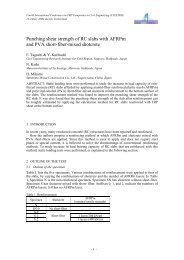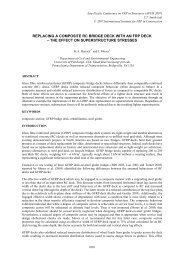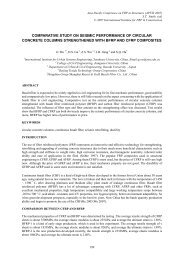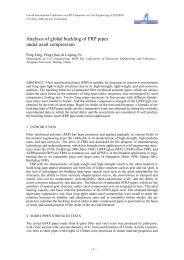construction of 300 m composite-deck bridge in korea
construction of 300 m composite-deck bridge in korea
construction of 300 m composite-deck bridge in korea
You also want an ePaper? Increase the reach of your titles
YUMPU automatically turns print PDFs into web optimized ePapers that Google loves.
distance between webs. In order to reduce the local deflection, the <strong>composite</strong> <strong>deck</strong> <strong>of</strong> quasi-triangular pr<strong>of</strong>ile is<br />
selected and fabricated by pultrusion as shown <strong>in</strong> Fig. 4. The pultrusion process is much more efficient than the<br />
filament w<strong>in</strong>d<strong>in</strong>g process especially <strong>in</strong> manufactur<strong>in</strong>g massive products. Extensive analyses and structural tests<br />
on the pultruded <strong>deck</strong>s are carried out. It is found that this pultruded <strong>deck</strong> needs further improvement to meet the<br />
criteria <strong>of</strong> local deflection and fatigue. Based on these pre-studies, the next <strong>deck</strong> pr<strong>of</strong>ile is developed and<br />
summary <strong>of</strong> the development is described <strong>in</strong> the follow<strong>in</strong>g section.<br />
a) Trapezoidal shape b) Box shape c) Triangular shape<br />
Figure 1. Fabrication <strong>of</strong> model <strong>deck</strong>s with VARTM process<br />
Fig. 2 Filament w<strong>in</strong>d<strong>in</strong>g <strong>deck</strong> Fig. 3 Test <strong>of</strong> FW <strong>deck</strong> panel Fig 4. Pultruded <strong>deck</strong><br />
COMPOSITE BRIDGE DECK OF TONGUE-AND-GROOVE CONNECTION – ‘DELTA DECK’<br />
Overview <strong>of</strong> Tongue-and-Groove Pr<strong>of</strong>ile<br />
Through the extensive studies described above, a <strong>composite</strong> <strong>deck</strong> pr<strong>of</strong>ile with tongue-and-groove connections<br />
called ‘Delta Deck’ is developed (Lee 2004). As shown <strong>in</strong> Fig. 5, it has 3 trapezoidal cells with 200mm height.<br />
The <strong>deck</strong> is designed for the Korean Highway DB24 truck load with typical girder spac<strong>in</strong>g <strong>of</strong> 2.5~3.0m. As<br />
shown <strong>in</strong> Fig. 6, the pultruded <strong>deck</strong> tubes are assembled together by bond<strong>in</strong>g each other to make a complete <strong>deck</strong><br />
panel. In each lam<strong>in</strong>ate <strong>of</strong> the <strong>deck</strong>, 8800 Tex E-glass rov<strong>in</strong>g <strong>in</strong> the longitud<strong>in</strong>al direction and multi-axial<br />
stitched fabrics (90°/±45°) <strong>in</strong> the transverse direction are used. Unsaturated polyester is employed as res<strong>in</strong> base.<br />
Fig.5 Pr<strong>of</strong>ile <strong>of</strong> ‘Delta Deck’ Fig. 6 Assembly by tongue-and-groove Fig. 7 Pultrusion <strong>of</strong> <strong>deck</strong> tube<br />
Research Summary for Tongue-and-Groove Composite Deck<br />
F<strong>in</strong>ite element analysis is carried out to verify strength and serviceability <strong>of</strong> the designed <strong>composite</strong> <strong>deck</strong>. A<br />
plate girder <strong>bridge</strong> simply supported with 30m span hav<strong>in</strong>g 5 girders with 2.5m spac<strong>in</strong>g is considered. Analysis<br />
is performed for the DB24 truck load (Fig. 8). As analysis results, the designed <strong>deck</strong> is considered to possess<br />
2.53 factor <strong>of</strong> safety for deflection (L/425 criteria), 10.4 for Tsai-Wu failure criteria and 10.7 for web buckl<strong>in</strong>g<br />
(Hyer 1988). The <strong>composite</strong> <strong>deck</strong> tube <strong>of</strong> 3-cell trapezoidal section with 200mm height, called ‘Delta-<strong>deck</strong>’ are<br />
fabricated by pultrusion process (Fig. 7). Coupon tests, flexural tests (Fig. 9), shear tests (Fig. 10), compression<br />
fatigue tests (Fig. 11), flexural fatigue tests, barrier wall tests, pavement shear tests and various chemical tests<br />
are carried out for this <strong>deck</strong>. Fig. 12 shows results <strong>of</strong> compression fatigue test under 2-million cycles <strong>of</strong> wheel<br />
APFIS 2007 1140


